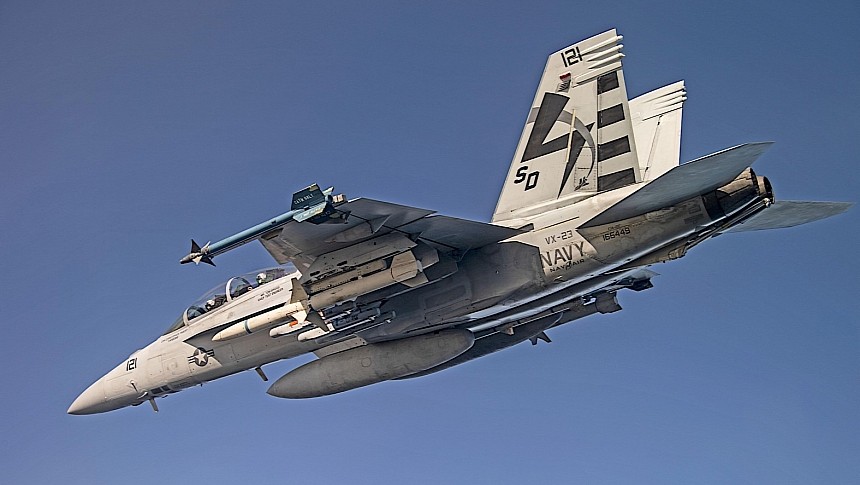The StormBreaker we're about to have a look at here is not the Bifrost-summoning axe made for Marvel's Thor, but a smart bomb. People used to refer to it as the Small Diameter Bomb-II, or the GBU-53/B, but no matter the term you use for it, it's now in the news thanks to a major development at the hands of the U.S. Navy.
StormBreaker is a product made by Raytheon, and it's essentially an air-launched precision-guided bomb that changes direction mid-flight and chases the target into the other world. It weighs 204 pounds (93 kg), with a warhead of 105 pounds (48 kg). That means it is small enough to be carried in larger numbers on fewer aircraft than similar weapons.
The guidance systems of the weapon comprises a tri-mode seeker (a combination of infrared camera, millimeter-wave radar, and semi-active laser) and GPS and inertial navigation. The thing can stay on target, even if it is moving, even in harsh weather, smoke or fog, and can receive instructions to change course mid-flight. The maximum distance it can strike at is 40 miles (64 km).
Development of the bomb began in 2006, and it was only in 2022 that it entered service. It is for now used solely by the U.S. Air Force as armament for the F-15E Strike Eagle, but there are also plans for the military branch to integrate it into the F-16C/D and F-35 as well.
Earlier this week the U.S. Navy announced it would use the StormBreaker as well. It did so after it declared Early Operational Capability (EOC) in October for the bomb deployed on the F/A-18E/F Super Hornet – it makes this particular plane the Navy's first platform to use it.
Initial Operational Capability (IOC), meaning the moment when the bomb will be at the minimum useful deployable configuration for the Super Hornet, is expected next year, but not before the Navy conducts two more operational tests.
The Super Hornet has been around since 1999, when it was introduced into service to replace the mighty F-14 Tomcat of Top Gun fame. Initially made by McDonnell Douglas (now Boeing), the plane can reach speeds of Mach 1.8 thanks to a pair of General Electric turbofan engines capable of developing 22,000 pounds of thrust each.
This plane is not particularly old compared to other flying war machines the U.S. military is using, but it is at the center of a modernization effort nonetheless. Aside from being integrated with new weapons systems, the Super Hornets will also receive upgraded electronic warfare capabilities.
Two companies are competing to win the final upgrade contract, but we know only of one of them so far, which just got an $80 million contract to develop the system: L3Harris. Upgrades on the planes should begin sometime in 2026, one year after Boeing will stop making new ones.
The guidance systems of the weapon comprises a tri-mode seeker (a combination of infrared camera, millimeter-wave radar, and semi-active laser) and GPS and inertial navigation. The thing can stay on target, even if it is moving, even in harsh weather, smoke or fog, and can receive instructions to change course mid-flight. The maximum distance it can strike at is 40 miles (64 km).
Development of the bomb began in 2006, and it was only in 2022 that it entered service. It is for now used solely by the U.S. Air Force as armament for the F-15E Strike Eagle, but there are also plans for the military branch to integrate it into the F-16C/D and F-35 as well.
Earlier this week the U.S. Navy announced it would use the StormBreaker as well. It did so after it declared Early Operational Capability (EOC) in October for the bomb deployed on the F/A-18E/F Super Hornet – it makes this particular plane the Navy's first platform to use it.
Initial Operational Capability (IOC), meaning the moment when the bomb will be at the minimum useful deployable configuration for the Super Hornet, is expected next year, but not before the Navy conducts two more operational tests.
The Super Hornet has been around since 1999, when it was introduced into service to replace the mighty F-14 Tomcat of Top Gun fame. Initially made by McDonnell Douglas (now Boeing), the plane can reach speeds of Mach 1.8 thanks to a pair of General Electric turbofan engines capable of developing 22,000 pounds of thrust each.
This plane is not particularly old compared to other flying war machines the U.S. military is using, but it is at the center of a modernization effort nonetheless. Aside from being integrated with new weapons systems, the Super Hornets will also receive upgraded electronic warfare capabilities.
Two companies are competing to win the final upgrade contract, but we know only of one of them so far, which just got an $80 million contract to develop the system: L3Harris. Upgrades on the planes should begin sometime in 2026, one year after Boeing will stop making new ones.










